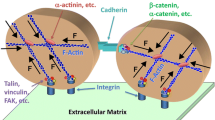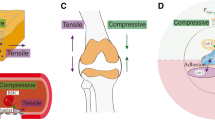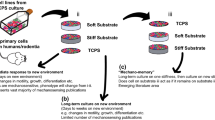Abstract
Mechanical forces are known to play important roles in determining cellular functions and behaviours such as growth, migration, wound healing and tissue regeneration, to name a few. It is quite intriguing how cells sense the mechanical forces and properties of the surrounding matrix in which the cells float or rest. The cells are known to build numerous ‘adhesion contacts’ at the cell-matrix interface to probe the surroundings. These adhesion contacts, known as ‘focal adhesions’ are highly dynamic and strongly force sensitive. In this article, we discuss about the focal adhesions which act as mechanosensors and, in turn, regulate cellular activity.
Similar content being viewed by others
Suggested Reading
T Iskratsch, H Wolfenson and M P Sheetz, Appreciating Force and Shape — The Rise of Mechanotransduction in Cell Biology, Nature Rev. Mol Cell Biol., Vol.12, pp.825–833, 2014.
B Geiger, J P Spatz and A D Bershadsky, Environmental Sensing Through Focal Adhesions, Nature Rev. Mol. Cell Biol., Vol.10, pp.21–33, 2009.
U S Schwarz and S A Safran, Physics of Adherent Cells, Rev. Mod. Phys., Vol.85, pp.1327–1381, 2013.
R De, A Zemel, and S A Safran, Theoretical Concepts and Models of Cellular Mechanosensing, Methods Cell Biol., Vol.98, pp.143–175, 2010.
D E Discher, P Janmey and Y L Wang, Tissue Cells Feel and Respond to the Stiffness of Their Substrate, Science, Vol.18, pp.1139–1143, 2005.
R De, A Zemel and S A Safran, Dynamics of Cell Orientation, Nature Physics, Vol.3, pp.655–659, 2007.
R De, A General Model of Focal Adhesion Orientation Dynamics in Response to Static and Cyclic Stretch, Communications Biology, Vol.1, Article No. 81, 2018.
W E Thomas, V Vogel and E Sokurenko, Biophysics of Catch Bonds, Annu. Rev. Biophys., Vol.37, pp.399–416, 2008.
G I Bell, Models for the Specific Adhesion of Cells to Cells, Science, Vol.200, pp.618–627, 1978.
Y Pereverzev, O V Prezhdo, M Forero, E Sokurenko and W Thomas, The Two-pathway Model for the Catch-slip Transition in Biological Adhesion, Biophys. J., Vol.89, pp.1446–1454, 2005.
N G Van Kampen, Stochastic Processes in Physics and Chemistry, Elsevier, 2011.
D T Gillespie, Exact Stochastic Simulation of Coupled Chemical Reactions, J. Phys. Chem., Vol.81, pp.2340–2361, 1977.
Author information
Authors and Affiliations
Corresponding author
Additional information
Rumi De is an Assistant Professor of Physics at Indian Institute of Science Education and Research Kolkata, India. Her research interest lies in the field of biological physics, soft matter, and nonlinear dynamics. Her current research focuses on cell mechanics, stick-slip dynamics, pattern formations, flocking and collective motions in living systems.
Rights and permissions
About this article
Cite this article
De, R. Cell Mechanosensing. Reson 24, 289–296 (2019). https://doi.org/10.1007/s12045-019-0780-x
Published:
Issue Date:
DOI: https://doi.org/10.1007/s12045-019-0780-x




